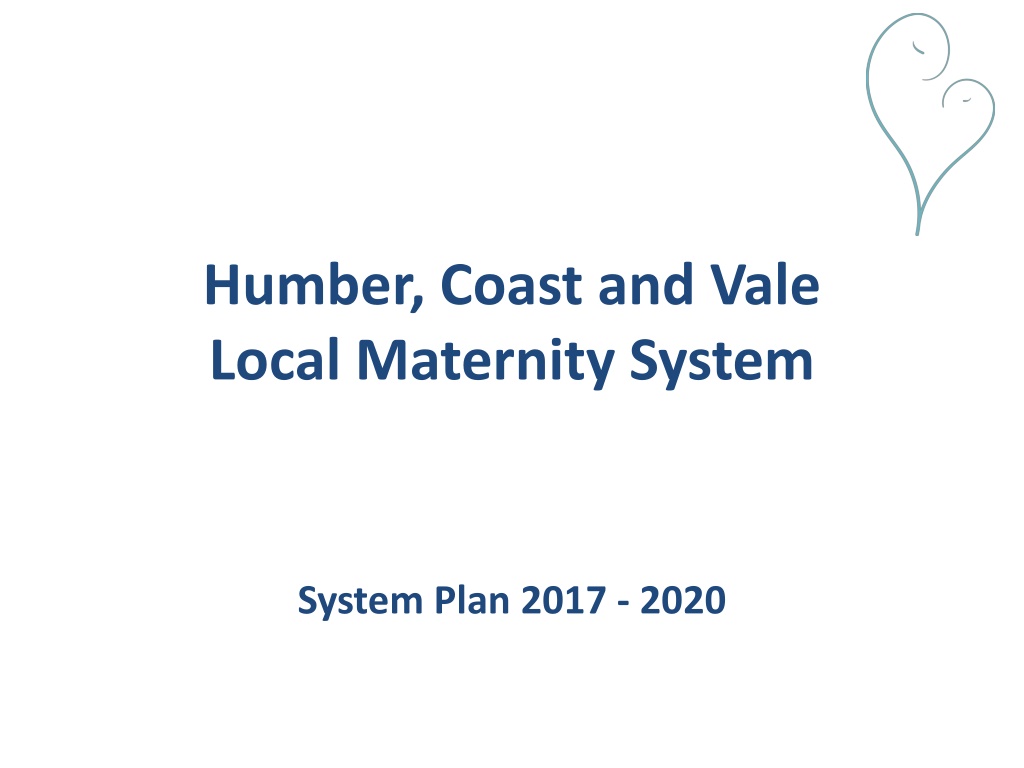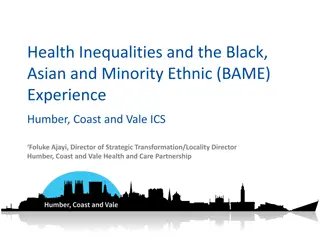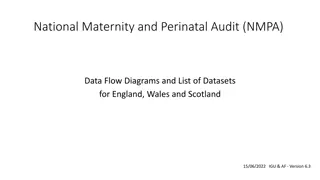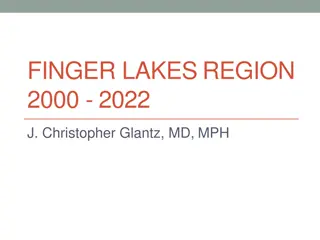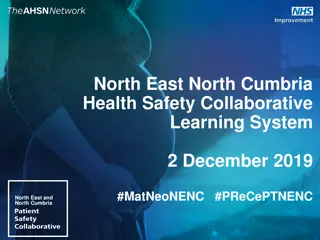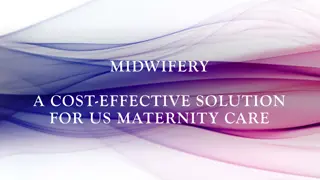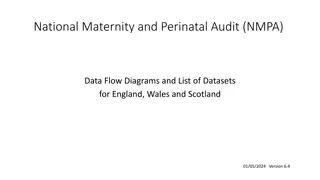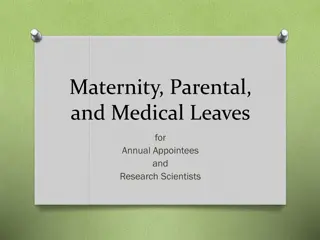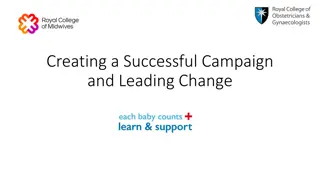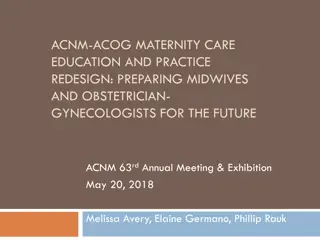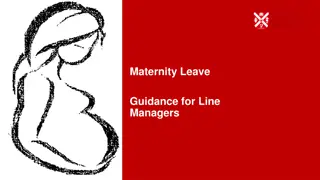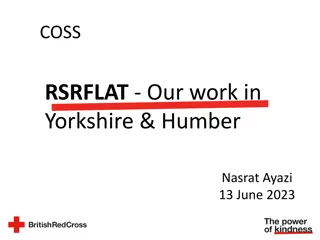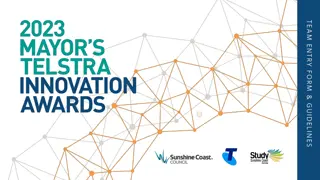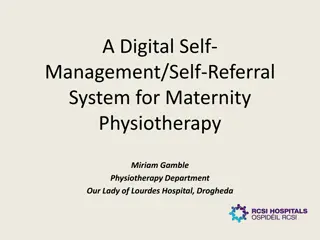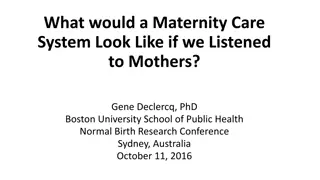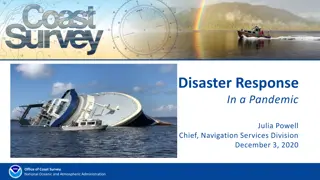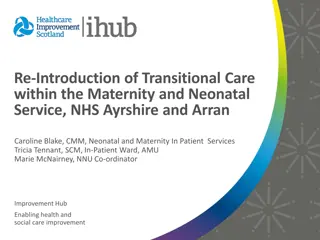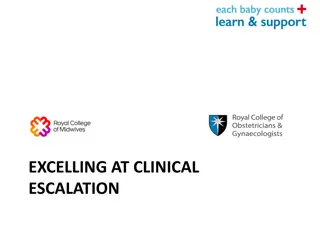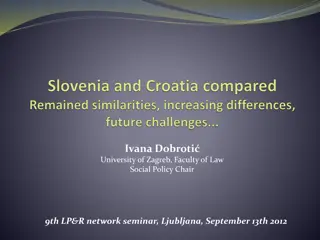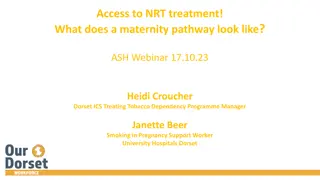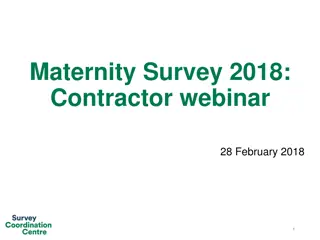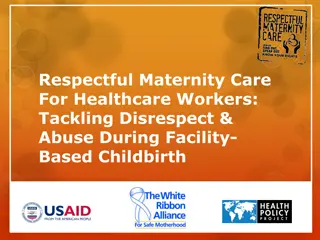Humber Coast and Vale Local Maternity System Plan 2017-2020
The Humber Coast and Vale Local Maternity System aims to provide personalized, choice-focused care for women and families during pre-pregnancy, pregnancy, and childbirth. Through collaboration and co-production, they strive to improve services, enhance staff skills, and offer a wider range of choices to meet the needs of their population.
Download Presentation

Please find below an Image/Link to download the presentation.
The content on the website is provided AS IS for your information and personal use only. It may not be sold, licensed, or shared on other websites without obtaining consent from the author. Download presentation by click this link. If you encounter any issues during the download, it is possible that the publisher has removed the file from their server.
E N D
Presentation Transcript
Humber, Coast and Vale Local Maternity System System Plan 2017 - 2020
Foreword Our vision as the Humber Coast and Vale Local Maternity System is to be an area where pre-pregnancy, pregnancy and childbirth services truly reflect the needs of our childbearing population and which focus upon delivering personalised care by kind, knowledgeable, skilful staff that is jointly agreed and planned with women and families. In setting this vision we recognise that: At present, in surveys, women often report that they have limited choice during pregnancy and childbirth and our aim is to change that so that women, their partners and, if required, their families do consistently have the offer of choices and are able to decide for themselves what is best for them and have been supported in this decision by the professionals that are providing the care they need. The maternity episode sets the basic foundation for the future generations by supporting the delivery of healthy children to families who are making, or are supported to make, positive lifestyle choices, from pre-conception onwards, as these early in-utero months and first years set the blueprint for the child s future. Additionally a pregnancy can be a wider motivator to positive lifestyle choices across the wider family and these opportunities need to be embraced. All our professionals who are involved in caring for women and families during the pre-pregnancy, pregnancy, delivery and post delivery period are highly skilled professionals in their own right and extremely dedicated to delivering the best care and outcomes they can whilst being kind and considerate of the women and her partners expectations. They have already started to make changes in the services they offer to further enhance the experience of women and families at this time and to better meet their individual needs but there is more that can be done. The development of the Local Maternity System provides us with an opportunity to work together across a wider system, and across organisations, to deliver those changes that are common to us all once and to share learning and good practice so that all the women we care for receive the best care we can offer. It will also help us to improve the range of choices that our women and families have including systemisation of choices across the whole LMS. Our staff will also benefit from improved opportunities to work across the LMS gaining a greater range of skills, or maintaining existing skills, LMS Plan V4 170921 2
We believe that the ideas set out in this plan reflect, and deliver, the national priorities outlined within Better Births (2016) and they also represent the right approach for the women and families across the Humber Coast and Vale Local Maternity System footprint . We are committed to co-production of solutions with both our staff and the women and families who use our services and we will not make any decisions without involving our population and our staff in the changes we believe we should make. We are now working collectively to deliver the best care possible as efficiently as possible with the resources we have to meet the health and care needs associated with pregnancy and childbirth in the best way. Kevin Phillips Chair and Operational Lead Humber, Coast & Vale Local Maternity System LMS Plan V4 170921 3
Contents Foreword Chapter 1 Case for Change Background Geography Our LMS Better Births 2016 Women s and Families Perspectives Self Assessment against Better Births Joint Needs Assessment How will we achieve our vision and address our case for change? System Governance Chapter 2 Work Programmes Improving choice, personalisation and continuity of carer Putting the individual, quality and safety at the core of our service delivery Neonatal Care Provider Quality Improvement Delivering Improvements in Perinatal Mental Health Multi professional working and governance Chapter 3 Supporting Work Streams Commissioning Models / Partnership Working Co-production, Participation, Communication and Engagement Developing Women and Family Perspectives Valuing and Developing our Workforce Workforce Options / Models under Consideration Finances Risks Equality Impact Assessment / Privacy Impact Assessment 2 6 7 8 9 10 11 12 13 15 16 17 18 21 25 27 28 30 33 34 36 37 38 39 40 41 45 LMS Plan V4 170921 4
Appendices Appendix 1 Draft Joint Needs Assessment Appendix 2 Project Plans Appendix 3 Inter-Dependencies Appendix 4 Contributors Separate Document Separate document 54 LMS Plan V4 170921 5
Chapter 1 Case for Change LMS Plan V4 170921 6
Background Humber Coast and Vale Sustainability and Transformation Partnership The Humber Coast and Vale Local Maternity System is coterminous with the Humber Coast and Vale Sustainability and Transformation Partnership. It covers the geographical areas of: Hull, East Riding of Yorkshire, North Lincolnshire, North East Lincolnshire, Vale of York, Scarborough and Ryedale. The Sustainability and Transformation Partnership (STP) is committed to working together in partnership to tackle the major health and care challenges it is facing across the footprint including: Organisations within the Local Maternity System include: 6 Clinical Commissioning Groups 3 Acute Trusts 3 Mental Health trusts 6 Local Authorities 2 Ambulance Trusts A range of other health and care organisations including community providers and community and voluntary sector organisations 23% of the 1.4 million population live in the most deprived areas of England Having an ageing population of which 8.9% are over the age of 75 which will lead to an increasing strain on health and care services. Variation in life expectancy for men is 20 years, and for women is 17 years across the best and worst areas of the footprint As part of the STP we recognise the STP s five priority areas (listed below) and are working to ensure that the work we undertake in developing our Local Maternity System not only delivers our specific plan outcomes but contributes to the STP s priority outcomes. The Sustainability and Transformation Partnership s five priorities focus on addressing Humber, Coast and Vale specific challenges, local place based delivery and on achieving national targets. The priorities are: Helping people stay well Place based care Creating the best hospital care Supporting people through Mental Health challenges Strategic Commissioning We have integrated our work on perinatal mental health with that of the STP Mental Health work steam to ensure we combine our expertise to deliver the best outcomes for our population. LMS Plan V4 170921 7
Geography Geographical area covered by the LMS This Local Maternity System covers the populations registered with: NHS Vale of York Clinical Commissioning Group NHS Scarborough and Ryedale Clinical Commissioning Group NHS East Riding of Yorkshire Clinical Commissioning Group NHS Hull Clinical Commissioning Group NHS North Lincolnshire Clinical Commissioning Group NHS North East Lincolnshire Clinical Commissioning Group Women registered with these Clinical Commissioning Groups are likely to receive the majority of their antenatal maternity care through Community Midwifery services and their Specialist Obstetric Consultant Care through one or more of the following Secondary Care Trusts: York Teaching Hospital NHS Foundation Trust; Hull and East Yorkshire Hospitals NHS Trust; and Northern Lincolnshire and Goole NHS Foundation Trust The physical geography includes urban and suburban areas, but also includes a significant number of patients who reside in rural settings which may lead to challenges related to the transport networks that are in place. LMS Plan V4 170921 8
Our LMS Our Vision: Personalised maternity care delivered by integrated high quality services which demonstrate the experience and outcomes that our population deserves We are clear that we all want to commission and deliver maternity care that is delivered by kind, skilled and will-informed professionals who ensure that women and families are treated as equals. This we enable us to deliver safe, personalised care where women and their partners are well informed of their options and choices, are listened to and are able to develop their personalised care plan with confidence. We recognise that for some the care they require will change during the maternity episode and we will ensure that the woman and her partner understands the reasons for the recommended change in the care plan and is able to make an informed choice regarding the way forward. Women have an expectations that pregnancy will be an enjoyable episode in their life with the delivery of a healthy baby and we will focus upon delivering this expectation. However we are aware that this expectation cannot always be met and where this is the case our women and their families continue to have a right to personalised care that meets their clinical needs at this time and supports them to understand what needs to or has happened. Our Commitments We will: Work together to develop and deliver a comprehensive plan of system and service change Define the interventions that will help to improve the quality and equity of our services and improve outcomes Ensure co-production, engagement and involvement with our service users and communities Adhere to the STP s Memorandum of Understanding Wider Vision The Humber Coast and Vale Sustainability and Transformation Partnership has a vision of start well - the work we do as a Local Maternity System is central to this Our Values The woman and family isatthe centre of everything we do Openness and transparency is central Active listening, involvement, co- production Our workforce is important to us Safety and quality is a right not an expectation Through collaboration we will jointly grow By the same rationale, we need women and families to be entering the maternity episode as healthy as possible with low levels of smoking and obesity and well controlled long term conditions LMS Plan V4 170921 9
Better Births (2016) 7 Themes Plans to implement the vision in Better Births will need to include delivery of the following by the end 2020/21: Improving choice and personalisation of maternity services so that: all pregnant women have a personalised care plan all women are able to make choices about their maternity care, during pregnancy, birth and postnatally most women receive continuity of the person caring for them during pregnancy, birth and postnatally more women are able to give birth in midwife-led settings (at home, and in midwife led units) Improving the safety of maternity care so that by 2020/21 all services have: made significant progress towards the halve it ambition of halving rates of stillbirth and neonatal death, maternal death and serious brain injuries during birth by 50% by 2030 with an interim target of 20% reduction by 2020 are investigating and learning from incidents, and are sharing this learning through their LMS and with others fully engaged in the development and implementation of the NHS Improvement Maternity and Neonatal Health Safety Collaborative programme LMS Plan V4 170921 10
Women and Families Perspectives Better Births (2016) is based upon the views of women and their families which were gathered as part of the plan development. In order to ensure that we prioritise those aspects of Better Births for early delivery that our local women want us to we will undertake an extensive involvement / engagement exercise. However we do have evidence from recent engagement work across Vale of York CCG, North East Lincolnshire CCG and Hull & East Yorkshire Hospitals NHS Trust that gives us an indication of current views. Views expressed include: A number of women told us no- one had spoken to them about their mental health Things that are important to us are: Respect and support Informed decisions Best health outcomes Local services We want local services close to home and flexible Yet in a different area 7 out of 10 women say they got information on the signs and symptoms of depression Some women felt that knowing your midwife made it harder to talk about more difficult subjects Women would like a named Midwife to build a relationship with Women value consistency of advice as much as consistency of carer We recognise that the information we have got is small scale and sometimes contradictory. We need to improve the level of co- production, involvement and engagement with women and families and will outline our plans later in this document (pages . LMS Plan V4 170921 11
Self Assessment against Better Births Our three main maternity services provider organisations; Hull and East Yorkshire Hospitals NHS Trust York Teaching Hospitals NHS Foundation Trust Northern Lincolnshire & Goole Hospital NHS Foundation Trust have repeated an initial self assessment against key aspects of Better Births undertaken in 2016. 2.4 The woman s midwife should liaise closely with obstetric, neonatal and other services ensuring that they get the care they need and that it is joined up with the care they are receiving in the community. Provider organisation boards should designate a board member as the board level lead for maternity services. The Board should routinely monitor information about quality, including safety and take necessary action to improve quality. Boards should promote a culture of learning and continuous improvement to maximise quality and outcomes from their services, including multi- professional training. There should be rapid referral protocols in place between professionals and across organisations to ensure that the woman and her baby can access more specialist care when they need it. Teams should collect data on the quality and outcomes of their services routinely, to measure their own performance and to benchmark against others to improve the quality and outcomes of their services. There is already an expectation of openness and honesty between professionals and families, which should be supported by a rapid redress and resolution scheme, encouraging rapid learning and to ensure that families receive the help they need quickly. Postnatal care must be resourced appropriately. Women should have access to their midwife as they require after having had their baby. Multi-professional training should be a standard part of professionals continuous professional development, 3.1 3.2 The second self assessment demonstrates that of the 27 recommendations within Annex A considered: 9 are fully compliant 16 recommendations have shown an improved RAG rating 2 ratings have demonstrated a decreased RAG rating associated with improved clarity of what was being assessed The recommendations associated with payment systems have not been self assessed due to the level of dependency on national work. 3.3 3.4 3.6 The self assessments will be reviewed in partnership with service commissioners to ensure that the evidence is in place to demonstrate the level of self assessment. 4.2 Areas where full compliance has been self assessed: 2.2 Each team of midwives should have an identified obstetrician who can get to know and understand their service and can advise on issues as appropriate 5.2 LMS Plan V4 170921 12
Joint Needs Assessment The deprivation score for the LMS based of the Indices of Multiple Deprivation (2015) is 22.91 with lower scores indicating less deprivation. However this average figure masks the extremes of deprivation scores across the LMS with York having a deprivation score of 12.28 whereas Hull has a score of 41.24. This means that whilst we can agree core approaches these will need to be flexed locally to reflect local need Number of women delivered 2,000 The Humber, Coast and Vale LMS has a total population of 1.37million individuals; approximately 35.5% (246,723) of these are females in the age-range 15-44 years, compared to 38.3% of the population of England. All but one of the CCGs have a lower than national average percentage of childbearing women. 1,000 Number 0 Jul-Sep 2015/16 Oct-Dec 2015/16 Jan-Mar 2015/16 NLAG Apr-Jun 2016/17 Jul-Sep 2016/17 York Hull The trend data shows a steadily rising trend over quarters one and two of 2016-17. There is a possibility that this is the start of a rising trend in pregnancies and deliveries, although this may also be chance variation in fertility rates. This data will help to consider the workforce challenges and skill mix necessary to ensure high-quality services are available. LMS Plan V4 170921 13
As an LMS, two of the Secondary Care Trusts are outliers for the number of caesarean sections they undertake. Hull and East Yorkshire Hospitals NHS Trust does significantly more caesarean section deliveries than other Secondary Care Trusts, and Northern Lincolnshire and Goole NHS Foundation Trust undertakes significantly fewer. There are a number of possible explanations for this, all of which will need exploring and may be clarified to a degree by splitting the procedures into those which were planned, and those which were undertaken as an emergency. Smoking during pregnancy has significant health impacts for the pregnant woman, the pregnancy, existing children, other family members and the unborn child. Smoking and therefore smoking in pregnancy is directly related to socioeconomic deprivation and as discussed there are some significantly deprived areas included in the LMS area. Some of the CCG areas are showing rises in the proportion of women who at still smoking at time of delivery rather than decreases Low birth-weight babies are associated with a variety of different factors, some of them intrinsic, some extrinsic. All of the Secondary Care Trusts are outliers in terms of low birth-weight babies, Northern Lincolnshire and Goole NHS Foundation Trust has significantly more low birth-weight deliveries at term, while York Teaching NHS Foundation Trust and Hull and East Yorkshire Hospitals NHS Trust have significantly fewer which is surprising given the levels of smoking at time of delivery in Hull and East Yorkshire Hospitals NHS Trust. Birth Outcomes Northern Lincolnshire and Goole NHS Foundation Trust, is an outlier inasmuch as a larger proportion of women appear to have a normal birth than would be expected, and that this result is greater than would be expected by chance. This could be due to the case mix of women being delivered there but further investigation is required to understand the difference. Further information can be found in Version 1 of the HCV LMS Joint Needs Assessment 2017 (annex 1), which sets out the information we have available to date. This document will follow an iterative process and will be developed and updated as information comes available. LMS Plan V4 170921 14
How will we achieve our vision and address our case for change? Alongside these work streams we know that we have major pieces of work / changes to our working practices to: In order to deliver our vision and address the items within our case for change we need to alter how we do things. Ensure our women and families have realistic expectations of their maternity care and genuinely feel involved in the care they receive Set aside organisational boundaries and develop a single culture of mutual co-operation, sharing and partnership Understand our workforce, both the current establishment and future predicted requirements to meet our ambitions around named Midwives and integrated care pathways Actively participate in wider prevention and health promotion initiatives with a specific focus upon those initiatives which are directly relatable to impacts and outcomes in pregnancy and childbirth We have identified four priority work streams within which we will work to deliver the change that we want and need. The work streams are: Improving Choice, Personalisation and Continuity of Carer Putting the individual, quality and safety at the core of our service delivery Delivering improvements in Perinatal Mental Health Multi professional working and governance These work streams will develop close links with the developing Maternity Voices Partnerships and other fora that support women and families to have a voice so that the final plans are co-produced with our population for our population. In support of this we will actively link into the STP s work streams on Communication Involvement and Engagement Information technology and Digital Roadmaps Local Workforce Action Board promoting the need to consider the unique needs of the maternity care pathway Each work stream will develop a project initiation document with a supporting project plan including agreed realistic but challenging timelines and trajectories. The delivery of these will be overseen by the LMS Executive, with progress being reported to the partnership workshops and an exception / delivery report will be received by the STP In-Hospital work stream. LMS Plan V4 170921 15
System Governance General Structure Humber Coast and Vale Local Maternity System is a core project within the STP Acute Care Group and reports to it on a monthly basis regarding progress. STP Strategic Partnership Board The STP Acute Care Group has been delegated by the STP Strategic Partnership Board to lead and coordinate all areas of work that primarily impact on acute hospital services, although it is acknowledged that whole pathways / services should be considered and these will cross into the Out of Hospital work programme. STP Acute Care Group North Region MTP Board LMS Executive Group Membership Each organisation in the LMS has a seat on the Executive Group Across the organisations there is a mix of clinical managerial, commissioning and quality experts in attendance How to best involve women and families is still being explored HC&V LMS Executive Group Putting the individual, quality and safety at the core of our service delivery Improving Choice, Personalisation and Continuity of Care Postnatal & Perinatal Mental Health Multi professional working and governance Workshops Quarterly workshops have been timetabled, rotating around the LMS footprint, to support wider involvement and co-production Cross Cutting Themes Co-production, participation, communication and engagement Use of Technology Workforce Prevention and health improvement LMS Plan V4 170921 16
Chapter 2 Work Programmes LMS Plan V4 170921 17
Improving choice, personalisation and continuity of carer What do we need to change? We know that all our women have personalised care plans, however we also know that not all of them feel they are fully involved in planning their care. We also know that they value consistency of advice. 2. Evaluation opportunities We commissioned at present within the LMS. We will map these and (i) services provided within the LMS boundaries that may not be formally commissioned, (ii) services provided close to our boundaries and (iii) specialised services that cover a wider footprint and then combine with data on reasonable travel distance. This will allow us to demonstrate service coverage and to identify whether there are any gaps in service. If service gaps are identified a market development plan will be developed. of future Service Choice This will support us to Better Births by: deliver know what services are currently Improving continuity of carer initially antenatal and postnatal, with a planned progression to include labour at a later date Our aim is to ensure that: All women / families have a voice in their pregnancy, labour and postnatal care All women / families feel that they have been able to develop their own care plan in partnership with their midwife When changes are advised these will be jointly discussed, understood and agreed All women / families will be cared for by a small team of Midwives members of whom they will have either met in person or been made aware of via a meet the team booklet All women / families will have a choice of care delivery options across the LMS Developing a comprehensive Local Maternity Offer 3. Ensure that all women have a small Midwifery Team providing the core continuity of care We have already put community teams in place that have a linked Consultant providing antenatal and postnatal care. We are looking at options to ensure that women are familiar with the Team members, including a meet the team booklet. We are planning to undertake an audit to assess women s views of continuity of carer which we will repeat at least annually. Supporting women to make better informed decisions regarding their care options What are we going to do? 1. Develop a Local Maternity Offer We will develop a core LMS care plan for women to access on line with a view to discuss and personalise with her named midwife throughout the maternity care pathway. This will be supported by work with professionals to enhance skills to ensure the woman and her family feel to have been genuinely involved. Improve women's ability to inform and be involved in service developments LMS Plan V4 170921 18
5. Explore options around innovative access routes to maternity care As we develop our maternity offer we will present it through a variety of formats. To meet this need we are developing a LMS Facebook page which will contain links to a wide range of information, online discussion forums and support groups. We will also develop a central information number which women will be able to use if they wish to speak to a professional. This will enable us to promote and better market home births and midwife led care We are reviewing opportunities to develop an online booking portal which will allow women to enter basic details and then be presented with a range of clinically appropriate options for booking. Women will then be able to choose an appointment to complete their booking with their preferred option. Planned Outcomes Existing constraints on the midwifery workforce means that including intrapartum care, except in home births, is not deliverable as part of phase 1 delivery of continuity of carer. As we progress through phase 1 we will review workforce and workforce planning and agree a date from when phase 2, intrapartum care will be included within the continuity of carer offer. Increased reporting involvement care planning self of in Increased reporting the knew midwives self that 4. Personalised Care Budgets We will work to develop a deliverable model of personal care budgets that meet the requirements of our local women and their families. women their Increased numbers women choosing midwife led care of 5. Develop the Maternity Voices concept We want all our service users to be able to contribute to the design, development and ongoing review of our services. Service options mapped and development plan agreed choice We will build upon existing Maternity Services Liaison Groups and existing Maternity Voices Partnerships across the LMS and review work within other LMS to develop Maternity Voices to ensure we are able to develop and deliver an LMS wide agreed model of Maternity Voices that best meets the needs of our local mothers and their families. market At present we have a mixed economy of parent education; face to face and online; and no core agreement on content. We will agree core content, role out the online model across the footprint and ensure all women are able to access face to face parent education locally if they choose to do so Quality assessed information sources accessible We will utilise online technologies to promote greater discussion across the whole footprint, as well as supported forums and work with our Maternity Voices members to develop systems that they agree will support participation. Maternity Voices Group(s) functioning See Appendix 2, project plans, page 1 Choice, Personalisation and Continuity for details LMS Plan V4 170921 19
Key Milestones Improving Choice, Personalisation and Continuity of Carer 85% of women will know the small team of Midwives who will provide their antenatal and postnatal care by April 2020 100% of women will know the small team of Midwives who will provide their antenatal and postnatal care by April 2021 LMS wide model of including intrapartum care within the small team of Midwives agreed by April 2020 40% of low risk women will have been cared for by a small integrated team throughout antenatal, labour and postnatal care by April 2021 LMS Facebook page operational 31 March 2018 Central contact number developed 31 March 2019 Review of existing models of online booking portals 31 March 2018 Opportunities linked with digital roadmap explored 31 March 2018 Portal developed, if a feasible option at this time, date to be confirmed Single core maternity care plan agreed across the LMS footprint 31 March 2018 Single core maternity care plan in place across the LMS 31 March 2019 Agreed core content of parent education 30 September 2018 Both online and face to face delivery options available to all women 31 March 2019 Model of Maternity Voices agreed 31 March 2018 LMS specific services and geographical coverage mapped by 31 December 2017 Geographically close services mapped by 31 December 2017 Market development plan developed December 2018 These milestones will be reviewed as work progresses to ensure they are achievable with appropriate levels of stretch LMS Plan V4 170921 20
Putting the individual, quality and safety at the core of our service delivery Review current services against best practice and develop a comprehensive action plan to address identified areas of improvement Review data on both neonatal and maternity services to understand any issues on organisational risk registers, incident rates, complaints, etc. to understand specific areas of perceived challenge What do we need to change? We all have maternity services as a priority, with Board level responsibility for the maternity services but we all know that there are always improvements that we can make to the quality and safety of our services. This will support us to deliver Better Births by: Reducing stillbirths, neonatal deaths, maternal deaths and injuries Our aim is to ensure that: Women and their families are central to our services Our services meet individual and family needs whilst promoting high levels of safety, quality and clinical outcomes. We identify high risk pregnancies early and manage them to minimise risk Neonatal services and the care of the sick neonate are an integral part of the services and pathways we deliver Review systems and processes to identify and manage predicted low birthweight pregnancies, sharing best practice and developing and adopting a single system / process for adoption across the LMS Working with the Neonatal ODN to review capacity, workforce and skill-mix across neonatal services to ensure the services are resilient and are able to respond to predicted demand levels brain Building our systems learning serious incidents to provide an LMS system sharing learning upon existing for from What are we going to do? 1. Reduce the level of stillbirths, neonatal deaths, maternal deaths and brain injuries in line with national requirements We have already made progress in reducing the level of stillbirths but we recognise that there remains more to do. wide 2. Build upon organisational systems for learning from incidents and near misses to develop an LMS wide system for sharing learning We will work to improve the consistency and robustness of systems and processes across the LMS to ensure that investigations are undertaken in a timely manner ensuring transparency of process and findings with the involved families. We will also review and enhance systems for sharing learning, both positive and negative, across the whole LMS and wider of Developing improved joint working the Neonatal Operational Delivery Network with In order to deliver the reductions we plan to: Establish the baseline from which we are measuring our reduction, confirm our current position and agree our 2020/21 target LMS Plan V4 170921 21
across partner systems if appropriate. Each of our maternity services have systems and processes in place, in conjunction with the CCG s Quality Teams, to quickly investigate complaints, incidents and near misses and then adopt the learning identified. We will utilise and develop these systems and processes so that the learning is shared across the LMS. identify areas where we are not performing to the level we expect. This will enable us to develop and deliver remedial action plans to improve the services we offer. This will support us to deliver Better Births by: Improving escalation pathways to and from neonatal services developing consistency the neonatal service offer 5. Develop and adopt consistent policies and service specifications around neonatal services (links with multi-professional working and governance workstream) We will work to ensure thatthe neonatal services across the LMS are working to the service level that we expect and that transfers between neonatal services for higher intensity intervention are undertaken as soon as identified to minimise the risk to the neonate and the mother. and 3. Develop closer links with the Neonatal ODN The LMS is uniquely placed to support both the Neonatal ODN and the service providers to improve quality. We know the Neonatal ODN has coordinated a peer review programme and we want the LMS to be involved with this. We respect the different roles of the ODN and the LMS but in order to improve quality we need to work together to understand the challenges and what actions the services are putting in place to rectify any areas of concerns. of Supporting the adoption national practice of best Where exceptions to the intended place of delivery for preterm babies occurs, for example in a pre 27 week gestation delivery, the Neonatal ODN has a process to review what happened and identify any learning in place. We will be seeking to link into the ODN s work and review any learning identified at the LMS Executive We will review existing pathways and refine where needed to ensure access to neonatal services is at an optimal time, pre-planned wherever possible and consistent. 4. Develop a quality dashboard for the LMS There is a wide range of data available from a number of different sources. We plan to identify all the relevant existing outcome measures and to review what they are telling us. We will then develop the data into both an LMS wide and individual service dashboard that we will use to We will also review and refresh where necessary anticipatory / risk assessment pathways associated with potential or actual sick neonates LMS Plan V4 170921 22
9. Review the information identified within the Joint Needs Assessment that identifies our services being outliers in the rate of normal delivery and caesarean sections We have identified that Northern Lincolnshire and Goole Hospital NHS Foundation Trust does higher than expected numbers of normal deliveries and lower than expected numbers of caesarean sections and that Hull and East Yorkshire Hospitals NH Trust undertake more caesarean sections than expected. These figures may be due to local demographics but we need to review this in more detail to understand what is actually happening and take action if there are service quality concerns. Planned Outcomes: 6. Adoption of national best practice and best practice pathways There are a range of NICE reviewed best practice and clinical pathways available. We will benchmark our services against these and develop action plans to undertake any identified service change needed A reduction in maternal deaths, stillbirth and neonatal deaths and serious brain injuries in line with national ambition 7. We will oversee the delivery of agreed action plans in response to CQC / Peer Reviews and other service quality / outcomes reports Our priority in relation to CQC action plans is to support Northern Lincolnshire and Goole NHS Foundation Trust which was identified as requires improvement . Local commissioners are working with the Trust to develop a case for change and then deliver an associated action plan, overseen by a Service Transformation Group. The LMS will be party to this Service Transformation Group seeking assurance that the plans put in place will deliver the improvement needed in a timely, cost effective manner. Systemised implementation of low birth weight pathways Standardisation of levels of openness and rigour around investigation less optimal care pathways / outcomes Agreed model for sharing clinical learning in place There is a planned national peer review process of neonatal services taking place over the course of this autumn and early next year through the Quality Surveillance Team of NHSE. The LMS will take account of the outcomes of these and support the Trusts to deliver any identified changes. See Appendix 2, project plans, page 2 Safety for details LMS Plan V4 170921 23
Planned Outcomes: Key Milestones Collation of existing outcome measures by 31 December 2017 Development of LMS specific dashboard by 31 March 2018 Development of LMS wide system to disseminate learning and support consistency of investigation processes by November 2019 Baseline, current position and improvement trajectory agreed for reduction in stillbirths, neonatal deaths etc. by May 2018 Programme of service reviews developed by 31 March 2018 with implementation from 1 April 2018 Review of processes around the identification and management of predicted low birthweight pregnancies by November 2018 Review of existing escalation pathways to neonatal care completed by 31 March 2018 Agreed plan of pathway reviews in place by 31 March 2018 LMS a member of the Northern Lincolnshire & Goole Hospitals NHS Foundation Trust Service Transformation Group by 31 October 2017 Northern Lincolnshire & Goole Hospitals NHS Foundation Trust Case for Change developed by tbc Review of Joint Needs Assessment identified outliers complete by 31 December 2017 All services are reviewed in a systemised manner by 2020/21 Northern Lincolnshire & Goole Hospitals NHS FT delivers the system changes required to improve it s services The level of safety and quality of services will have improved by 2020/21 demonstrated through agreed quality measures These milestones will be reviewed as work progresses to ensure they are achievable with appropriate levels of stretch LMS Plan V4 170921 24
Neonatal Care Developing models of care We will work with neonatal ODN to refine and develop robust pathways of care including escalation into neonatal services and proactive transition back to the lower levels of care as the neonates condition indicates. We will develop systems to review, in conjunction with the ODN, any deviations from the agreed pathway. Maternity services cannot be considered in isolation and are inextricably linked to neonatal services, which are key in delivering optimal outcomes for babies. Neonatal services provide, alongside maternity staff, an oversight of care for all babies who are at risk of, or have developed complications. This includes babies born too early, babies with congenital abnormalities and babies who experienced complications during birth. System Resilience We will work to ensure that women and neonates will be cared for in a clinically appropriate service as close to home as possible. Whilst our focus is upon reducing admissions to neonatal units and any potential separation of mother and child we will also focus on improving outcomes for those infants that do need to be admitted. In addition we will work with providers to ensure there is sufficient capacity, of the correct level available to support the LMS and meet the needs of its population. We will aim to have sufficient capacity to provide all neonatal care for at least 95% of babies who require admission for neonatal intensive care and are born to women booked for delivery in the network and maintain an annual average of 80% bed occupancy. Working in close collaboration with the neonatal operational delivery network we will focus upon: Action on Mortality - Pre-delivery We will reduce the number of women who deliver in a centre without a neonatal intensive care unit pre 27 weeks gestation where the reason for the delay was avoidable. We will work to develop appropriate screening of high risk women and to promote the use of antenatal steroids and intra partum magnesium sulphate to improve outcomes. Term Babies Admitted to Neonatal Units We will develop a process to review admission of term neonates to identify root causes and lessons to be learnt and ensuring ATAIN is implemented LMS Plan V4 170921 25
See Appendix 2, project plans, page 2 Safety for details Mortality Reviews Any neonatal deaths must be reviewed to identify root cause and enable lessons to be learnt. Neonatal transport We will review the 2016 data received from the Neonatal Transport Group to Assess the reasons for: Babies being transferred because of lack of capacity (space or staff), Babies being transferred for more specialised care Any babies transferred in the first 3 days who should have been born in an intensive care unit in the first place We will review the situation on an annual basis Workforce Neonatal services need to be delivered by suitably qualified, multi-disciplinary teams. Often these teams are constrained due to gaps in core professionals. The LMS will review, as part of wider workforce work linked into the LWAB, progress against neonatal workforce development plans and seek remedial delivery plans if required. Quality Improvement We will review the outcomes of the QST reviews and the improvement plans developed as a consequence. We will also review the specialised dashboard. commissioning quality LMS Plan V4 170921 26
Provider Quality Improvement The LMS, as a party to the quality forums, will actively link with the contracting functions and systems that are currently in place to ensure there is no duplication of work and actions being undertaken. Part of the responsibility of the LMS is to ensure that the users of our services receive the best quality and outcomes that we can provide / commission. In support of this we will ensure that the quality forms that are in place with each providers have the needs of the maternity and neonatal care system clearly within their remit. These forums will maintain a general oversight of quality and performance within the providers with core representatives of the LMS present to ensure that work across the Quality Forums, the LMS and the STP are coordinated and that all involved partners are kept abreast of actions / concerns. Northern Lincolnshire and Goole NHS Foundation Trust This Trust has recently had a follow-up inspection by CQC which found that insufficient progress had been made against concerns raised at the initial inspection. The LMS has been invited to have a representative on the group looking to address the issues raised within the CQC report to ensure that women who opt to deliver within Northern Lincolnshire and Goole NHS Foundation Trust can access high quality care and an optimal experience. Working as part of the In-Hospital workstream of the LMS we will support, and be actively involved in, any reviews of obstetric, midwifery and neonatal care services; including outcomes, experience, capacity and safety factors. This will enable the LMS to ensure that sufficient safe, high quality services are maintained to meet the needs of eth local population whilst ensuring that choice is maintained across the LMS footprint. There will be a standing item on the LMS Exec to look at quality issues in all commissioned services to ensure that any reduction in the standards delivered are identified early and remedial actions put in place. See Appendix 2, project plans, page 2 Safety for details LMS Plan V4 170921 27
Delivering Improvements in Perinatal Mental Health To work with key partners, including the Maternity Voices Partnership (MVP) to ensure that the voices of women and their families with lived experience are captured and embedded in all areas of service development making sure we include the service user input and comments To improve early identification and early support, targeted and specialist perinatal mental health services to ensure we provide the right care, first time and as close to home as possible. This will include reducing inappropriate out of area mental health placements including Mother and Baby units. To ensure there is a suitably competent and confident workforce to support the delivery of integrated care pathways from early identification and support through to specialist perinatal mental health services. To raise awareness throughout the LMS community of perinatal mental health thus reducing stigma and promoting resilience and self-management; with an emphasis on the supporting role of the family and the voluntary and community sector. To ensure that perinatal mental health information, advice and guidance (IAG) is included in the LMS local maternity offer. This will support us to Better Births and the requirements of the Health Taskforce by: Our aim Our aim is personalised perinatal mental health care delivered by integrated high quality services which are equitable, accessible and responsive to women and their family s needs. Perinatal mental health services are for women during pregnancy and in the first year after birth deliver Mental Improving consistency services across the LMS the of Our objectives: To have a clear and integrated perinatal mental health pathway of care, supported by strategic planning to identify current provision and improvement areas across the LMS, that will be localised within the defined maternity community hubs. To ensure that all commissioners within the LMS commission services for physical and mental health that are integrated and enable women to experience equitable, high quality personalised maternity care. We will endeavour to ensure that investment in perinatal mental health services are protected and increased where appropriate through service transformation and efficiencies. To have a focus on perinatal mental health for vulnerable women to include for example BME, refugees, asylum seekers, travellers, teenage parents, looked after children, those with learning difficulties and cognisant with factors that indicate safeguarding concerns. offered Improving early recognition of systems the Systemising screening and treatments to those demonstrable positive impacts tools with Delivering personalised mental care planning health Delivering Maternity Voices LMS Plan V4 170921 28
To ensure that there is an established perinatal mental health network that supports strategic working and service improvement, ensuring that this work is reflected in the local maternity community hubs. Planned Outcomes 3. We will undertake a baseline assessment of services, workforce (including workforce development), and performance data taking into consideration the focus on vulnerable women and groups. A whole system approach to the delivery of an agreed perinatal mental health integrated care pathway, which strengthens transition arrangements between and across services What are we going to do? 1. In order to ensure effective implementation, integration and delivery we will work with Our Maternity Voices Partnerships Our other LMS work streams The HCV Mental Health Executive Board The Y&H Maternity Clinical Network and the Yorkshire and Humber Perinatal Mental Health Steering Group The national maternity transformation team Our neighbouring STPs Specialist commissioned mental health services including Mother and Baby units NHS England Commissioners and networks The maternity community hubs to ensure local delivery of the overarching LMS perinatal mental health delivery plan. 4. We will utilise the MVP to ensure we gain women and their families views on perinatal mental health issues on an on-going basis. We will ensure service user representation is integral to the work stream and integral in the development, delivery and monitoring of our plan. An improved local offer for perinatal mental health reducing inequalities and variation across the LMS We will further develop an understanding of the needs of fathers, partners and families with regard to their mental health. We will also use this opportunity to drive forward improvements in infant mental health. 5. We will agree an LMS-wide workforce development plan informed by the workforce assessment and gap analysis. This will include the development and delivery of specialist roles in maternity and health visiting, perinatal mental health champions and ambassadors. To include the recommendations from the Five Year Forward View in relation to staffing and workforce development. Improved access to, and uptake of, perinatal mental health services 2. We will develop an LMS integrated perinatal mental health care pathway based on national guidance for implementation by the local maternity community hubs. LMS Plan V4 170921 29
Workforce training and development will include systemisation of evidence based screening tools that support integrated personalised care planning and delivery 8. Identify digital opportunities in relation to perinatal mental health for both the workforce and services users and their families for utilisation across the integrated perinatal mental health pathway. Planned Outcomes Improvements in support to fathers and partners. 6. We will secure the resource to deliver the transformation needed across the LMS. This will initially be supported by submission of the funding application for the national perinatal mental health community service development fund. Should this be unsuccessful, the work stream will develop and implement an alternative transformation plan which achieves our objectives. In any event, our transformation will look to secure services which will deliver safe sustainable services beyond 2020. A more competent and confident workforce, with the correct capacity and skills mix. Improved service user experience. 7. We will develop, and implement, a perinatal mental health local offer which will be promoted and publicised through a clear communication strategy and within the LMS website with links to key stakeholders. The communications strategy will have both professional and public facing elements and will also be localised and implemented through the local maternity community hubs. Reduced variation in access to, and availability of, perinatal mental health services and outcomes for mum, baby and family See Appendix 2, project plans, page 3 Perinatal Mental Health for details LMS Plan V4 170921 30
Multi professional working and governance Wherever possible develop joint training and shared experiences between professional groups to ensure that common skills are developed and greater understanding and respect o differing professions expertise The LMS culture evolves into a multi-professional, collaborative, women and family centred culture which recognises the individual worth of all it s staff and the woman and families it cares for This will support us to Better Births by: What do we need to change? In providing care and support for women and their families a wide range of professionals can be involved including midwives, obstetricians, sonographers, family nurses. We need to further improve how these professionals work together to avoid duplication and to minimise the number of professionals that are involved in any one women's care. In order to do this we need systems and processes in place that support our professionals and provide a clear framework within which they work to support them to deliver high quality, safe care to women who are equal partners in care and decision making. deliver Ensuring the LMS works within a robust framework Ensuring women receive the same level of care and a consistent service offer across the LMS What are we going to do? 1. Align structures across the LMS to deliver seamless care We will review our existing governance structures to ensure that best support the LMS to do its work and that the LMS is filly integrated into the STP s governance. Robust governance supporting everything we do clinical Our aim is to ensure that: Have a robust organisational governance model across the LMS, linking into the STP governance, which provides a clear framework within which we will all work and be held to account within An LMS wide model of clinical governance is developed that promotes shared policies, protocols and pathways; in line with the STP s approach to clinical governance Women are cared for by professionals who are skilled, kind, have excellent communication skills and are supported to care for the woman in line with the care plan We will work within the STP to utilise their leadership development to ensure that leaders within the LMS have an opportunity to develop Developing learning which shares and learns as a matter of routine a system 2. Clinical and operational governance will be developed (links with the choice, personalisation and continuity workstream) We will review the service offer across the LMS and develop the whole LMS s understanding of what is offered in arts or across the LMS. Ensuring inclusive transparent, accountable culture an LMS Plan V4 170921 31
Planned Outcomes We will seek to systemise these so that women across the LMS have access to the same service offer 4. A collaborative culture will be developed We will support the development of a culture across the LMS that: Recognises professional skills and competencies Values kindness, transparency and openness Respects all staff and the women and families using the services Refreshed organisational governance across the LMS We will develop, alongside the in-hospital workstream of the STP, a single model of clinical governance working to align our core policies, protocols and pathways, recognising the need to vary minor details to reflect demographic requirements. Policies, protocols, pathways and standards will be aligned Pathways will be developed to allow women , and babies, to move between services and systems either through choice or because of changed decision making based upon clinical need. Rapid referral protocols and pathways for both mothers and babies will be developed across the LMS. Workforce will be reviewed and developed Record keeping and maternity notes will be consistent across the LMS, and wherever possible beyond to neighbouring services / LMS Women their will be central and families 3. An effective multi-professional workforce will be developed As will be described in the workforce section on pages to our workforce is our most valuable asset. We will work to ensure that our professionals work together across organisational boundaries in the best interests of women and babies. These will need to include all providers across the LMS footprint and those providers beyond where we have routine pan LMS pathways e.g. clinical genetics High safe, consistent care will be in place the LMS quality, across See Appendix 2, project plans, page 3 Multi-Professional & Governance for details LMS Plan V4 170921 32
Chapter 3 Supporting Work Streams LMS Plan V4 170921 33
Commissioning Models / Partnership Working Outcomes based commissioning In line with wider commissioning principles we will commission for outcomes in relation to maternity and neonatal care. The local contracting approach has evolved differently across the STP footprint. However this has not affected how we commissioning. Inter-Dependencies The LMS cannot work in isolation. There are a wide range of functions and organisations who have a vested interest in the commissioning and outcomes of maternity and neonatal services. Appendix 3 provides details of the differing interests. The LMS will work actively with all identified partners to ensure that outcomes, plans and actions are aligned and duplication is avoided. Integrated Commissioning and Planning All Commissioners (CCGs, PHE/Local PH, Specialised Commissioning), providers and Networks (maternity clinical network, Neonatal ODN) will work together on the LMS footprint to deliver coordinated planning and commissioning of outcomes; including optimal pathways and integrated services; to avoid fragmentation or duplication and to promote integrated pathways focussed around the women, neonate and family Specialised Commissioning Our specialised commissioning colleagues have a range of interfaces with the LMS. They commission a range of tertiary services on the footprint which have been mapped. They also are responsible for the delivery of the Neonatal Operational Delivery Network which has a direct interface with the LMS and how services operate across the LMS. We will ensure that the outcomes described by the LMS are aligned with other local plans and with the plans of partner commissioners commissioners, PHE/PH and Networks including the Maternity Clinical Network and the Neonatal Operational Network They also commission wider specialised services that are delivered outside the LMS footprint, for example : clinical genetics, specialised maternal and foetal medicine, neonatal and paediatric surgery. including specialised LMS Plan V4 170921 34
In order to ensure that the commissioned pathways are integrated our specialised commissioning colleagues are members of the LMS executive, and the STP executive. There are close links between the commissioners and the Specialised Commissioning Oversight Group (SCOG) and active participation in the associated work programme, which at present is focusing on paediatric services. The LMS is committed to ensuring that women, neonates and their families are able to access the specialised services they require without discernible boundaries and at the point of need. See Appendix 2, project plans, page 5 Cross Cutting, Outcome 1 for details LMS Plan V4 170921 35
Co-production, Participation, Communication and Engagement We are committed as a LMS to co-producing all our plans, service specifications and expected outcomes with our workforce and our service users (woman and families). We will develop a programme of communication and information sharing to raise awareness of Better Births and awareness of our local vision and ambition. This includes the development of the LMS Local Offer. Central to this is the development of Maternity Voices Partnerships. These Partnerships will be independent to the LMS and will provide an independent view and voice to inform our decision making. There is an existing Maternity Voices Partnership in the south of the LMS area (North and North East Lincolnshire) and we will use the learning from setting this Partnership up to inform how we transition our existing Maternity Services Liaison Committees into a Partnership. Further details are provided within section 2 page 19. We recognise that we have a low percentage of our population coming from other national and ethnic backgrounds with the core ethnic groups being: Central European Asian Traveller / Romany This means that we have to take especial care to ensure that members of our minority groups are able to access the maternity care they need and expect as well as ensuring that they are able to put forwards their views and actively engage with our co-production work. In order to supplement the role of the Maternity Services Partnership we are putting in place a range of systems and processes to help us increase gain regular information and feedback from our women, some of our proposals are identified on the next page. As our plans progress we may need to consider changes that require more formal engagement and communication. In this event we will follow national guidance on process and requirements. We are also seeking service user representation on our workstreams and their underpinning task and finish groups. We are also planning to undertake a series of workshops, focus groups and online surveys / discussion forums to support participation especially amongst our harder to reach groups. We understand that participating is a daunting prospect for many and we are aiming to be as flexible as possible to support this. See Appendix 2, project plans, page 5 Cross Cutting, Outcome 2 for details LMS Plan V4 170921 36
Developing Women and Family Perspectives Maternity Voices Partnership We will systematically implement Maternity Voices Partnership(s) bringing together the best of our existing Maternity Voices Partnership(s) and our Maternity Services Liaison Committees , other independent women s forums, groups that represent our smaller more marginalised population groups and our current or recent service users. This will enable us to plan and evaluate our services in a much more collaborative way and deliver effective co-production of service specifications and outcomes. Partnership Working: We will interface with the wider LMS organisations including Healthwatch , voluntary and community websites / forums, STP, and non-health services such as police services etc. to ensure that we maximise the distribution of our proposals and maximise the level of involvement and engagement. We will also use the Maternity Voices Partnership to help us identify the best ways to effectively work with our women and families and to support us in undertaking family friendly forums Friends and Family Collation and interpretation of the Friends and Family feedback that we get on our services Using Technology We propose to develop an LMS Facebook page which will be used to provide information on the services we offer (our service prospectus), support discussion forums, provide or link to information on pregnancy, labour, the postnatal period and common clinical issues including mental health Ethnic / Culturally specific Involvement and Support Plan: We will: Have agreed our model of maternity voices by 31 March 2018 and have commenced development with an aim of having Maternity Voices fully in place by September 2018 Have an operational Facebook page by 31 March 2018 Have refined our communication plan to incorporate ongoing learning and the individual workstream plans Part of developing our understanding of women s and family perspectives is developing an understanding of the ethnic and cultural requirements around pregnancy and childbirth. This will enable us to ensure our service developments meet the needs of all our population and all our population can be involved in developing these services. We will also adopt the national maternity app when available and look at a local app based solution to complement. Appendix 2, Project Plans, page 5, outcome 1 for details LMS Plan V4 170921 37
Valuing and developing our workforce Our workforce is our single most valuable asset. We need to develop an approach which means our current workforce is able to directly influence the environment in which they work; e.g. working patterns, service design; believe they have the level of professional autonomy they require and ensures that our workforce feel valued by their employing organisations. Looking forward we also need a system which attracts, and keeps, in new staff across all professions to ensure that we meet safer staffing guidelines. Nationally it is estimated that, as a minimum, by 2021 the workforce needs to increase by: Midwifery 2.4% Obstetricians 11.6% (complicated by inclusion of gynaecology requirements) There is no evidence to suggest that this should be different within the LMS, but the figures do not allow for current gaps in staffing. We know we need to work in partnership with both our staff and with other organisations to deliver this. In the first instance we will work within the STP s workforce plans and the Local Workforce Action Board (LWAB) to make sure we are accessing their expertise around workforce and to ensure that workforce plans reflect the needs of the maternity workforce. We will work with the LWAB to explore how we can develop their two key work programmes: (i) Support staff at scale (ii) Advanced practice at scale Within the maternity setting allowing us to utilise staff where their skill set is best used. We know our workforce has a relatively higher proportion of more mature midwives, Consultants and other professionals who are considering their options around retirement which could lead to a significant loss of knowledge and skills over a relatively short period of time. We will also look at what is needed to support our staff to develop the knowledge, skills and behaviours which will help them deliver the developing models of maternity care. We also need to consider safer staffing and apply that to our workforce calculations to ensure that we are meeting national requirements on staffing levels and associated safe practice. At the other end of the career spectrum we have a range of younger midwives, Consultants and other professionals who are well educated and skilful but need to further enhance their skills as they develop their careers. This group also tend to articulate a clear view on work life balance. The next page outlines some of the areas we are planning to explore. LMS Plan V4 170921 38
Workforce Options / Models under Consideration Integrated Workforce We are looking to explore models where clinicians can work across the wider STP to develop and maintain their skill set especially in units where a specific intervention may be required infrequently. By rotating staff into units where the intervention is routine will support skill development / maintenance and service resilience. Common Skill Set We also want to consider developing an agreed skill set, skill recognition method so that staff can consistently evidence their transferable skills. We would want to support tis with joint training programmes across all disciplines to help remove professional barriers . Innovative posts As with the link to the LWAB work we want to look at innovative posts, from informal, lay support (e.g. doulas), through physicians aides / midwifery aides. Thus enabling staff to use their whole skill set for the benefit of eth women and families they are caring for. Culture We appreciate we need to start changing the culture from the bottom up so that our workforce has the knowledge, skills and autonomy to deliver the care their families are asking for as part of their personalised care plans. Leadership We need to develop, in line with work within the STRP and LWAB leadership programmes which will encourage the development of leaders at all levels of our organisations. Other Professionals As an LMS we are dependant upon professional groups that work within specialised services covering more than the LMS, for example clinical genetics. We will work with health Education England, Specialised Commissioners and partner LMS to ensure that we have sufficient service coverage to meet all our needs. Expected benefits for our staff including: Less duplication in the way they work Increased job satisfaction More fulfilling job roles and career opportunities, as a result of working across typical organisational barriers Opportunities to work seamlessly across care settings. Expected Outcomes Existing and predicted workforce understood for the LMS including projected staffing numbers and skill mix Development of joint training programmes accessible to all linking with proposed learning academies A joint understanding of the current and future models of service delivery We will further link our plan with the Health Education England action/delivery plan when it is published. See Appendix 2, project plans, page 4 Multi-Professional working for details LMS Plan V4.1 170927 39
Finances LMS Finances The LMS, as part of the HCV STP, will adhere to the financial parameters set out and utilised across the footprint. Financial Planning Assumptions LMS activity growth will be in line with STP planned population growth Confirmed birth rate growth within parameters of predicted population growth The system needs to deliver efficiencies to meet financial parameters By ensuring women can choose the care model they prefer and ensuring they get the right care first time efficiencies will be delivered by reduction in duplication Innovative contracting models to be utilised Impact of proposed maternity tariffs needs assessing when available Review of the spend on midwifery and obstetric care has demonstrated that there is no consistency across the three main contracts in how activity is collated; for example: NHS Hull and NHS East Riding appear to spend the most NHS North East Lincolnshire appears to spend least However North East Lincolnshire monitor their spend via HRGs, which the other areas don t and this potentially impacts upon the identified figures STP Finances STP Finance design principles: Operate a single control total for HCV STP; early work has commenced to ensure that the single control total operates formally from 2017/18 Look at establishing alternative payment mechanisms for 2017/18 onwards which have collective focus on managing activity levels and reducing cost. Two main models are in use across the STP: Capped Expenditure Programme York health economy North and North East Lincolnshire health economy Aligned Incentive Contract Hull and East Riding health economy Financial Planning Next Steps Work is required to systemise how maternity activity and finance is recorded across the LMS Predicted spend by 2020 to be calculated based on predicted increase in maternity activity Impact of changes to midwifery delivery models and workforce numbers to be modelled Planned changes to services to be quantified with respect to both activity and finance See appendix 2, project plans, sheet 5, cross cutting , outcome 3 for details LMS Plan V4 170921 40
Activity 60,000.00 50,000.00 40,000.00 30,000.00 Activity 20,000.00 10,000.00 - NL S&RHull NEL ERY VoY NL S&RHull NEL ERY VoY NL S&RHull NEL ERY VoY NL S&RHull NEL ERY VoY Midwifery Services Neonatology Obstetrics Well Babies Cost ( 000) 9,000 8,000 7,000 6,000 5,000 4,000 Cost ( 000) 3,000 2,000 1,000 0 NL S&R Hull NEL ERY VoY NL S&R Hull NEL ERY VoY NL S&R Hull NEL ERY VoY NL S&R Hull NEL ERY VoY Midwifery Services Neonatology Obstetrics Well Babies LMS Plan V4 170921 41
Risks Top Programme Risks Risk Impact Mitigation Day to day operational management prioritised over strategic change Changes not implemented in a timely manner Loss of confidence in plans due to non- delivery Commitment from all organisations, via the MOU, to support the strategic work Effective programme management / project support Deliverable plans with the right amount of stretch Competing priorities between managing operational service challenges and developing/implementing strategic change leading to delays in delivering strategic change Workforce constraints limits opportunities for staff to participate Reluctance to consider alternative working patterns as perceived as having negative impact Insufficient staff to deliver the identified level of service Involvement of staff early in plans to ensure high levels of ownership Models of sharing training, skills development/maintenance developed Review plan timelines against projected staff availability / recruitment and training plans Lack of availability of key, appropriately skilled workforce to support and deliver proposed changes Overall STP driver is around stabilising/reducing expenditure, if costs rise there will need to be a corresponding reduction elsewhere in the system Review of national models being developed to better understand associated cost pressures Development of maternity personal budgets Changes to workforce model and move towards more personalised midwife led care leads to increased financial pressures on the system Time wasted doing things more than once Different outcomes which then need integrating Strong governance structure across the LMS Monthly updating by workstreams to Exec PMO to continually review for duplication Duplication of work between different workstreams LMS Plan V4 170921 42
Risks Choice Personalisation and Continuity Risk Impact Mitigation Lack of awareness across the senior medical team about the work of the LMS Disengagement from the choice agenda Destabilisation of the LMS with potential that pathways of care will not be aligned to Obstetric care Raised at CEG meeting and the Obstetric Forum Request to be sent out again for full representation Alternative methods of communication to be agreed Agree LMS communication strategy Lack of wider professional engagement within the LMS workstreams Due to the large work programme for this particular group especially in relation to achieving the MVP the implementation of the recommendations from Better Births would be incomplete or not achieved Inability to deliver all elements of the Task & Finish Group for Choice, Personalisation, Continuity of Care, Maternity Voices Partnership Proposal to the Executive Board that the MVP is separated and has its own Task and Finish Group Utilising national funding appropriately to support a leadership framework within the LMS Non engagement of service users Developments of LMS would be constricted and would not be co- produced with service users Destabilisation of the LMS with potential that pathways of care will not be aligned to Obstetric care Proposal to the Executive Board that the role of service users is appropriately recognised and resourced Lack of Maternity Voices and Stakeholder engagement LMS Plan V4 170921 43
Risks Perinatal Mental Health Risk Impact Mitigation Significant impact to delivery and continued inequalities of access and provision across the Y&H Sub group set up to develop a robust Wave 2 bid Letters being sent to all CCG s and Providers to seek advance support for the bid, and, in the case of the 4 CCG s in the Humber, advance approval to fund out of baselines after the first year of the bid Lack of financial investment to deliver the recommendations of Better Births (BB) and the 5-Year Forward View (5YFV) Perinatal Mental Health Pathways in Y&H do not reflect the needs, aspirations and lived experiences of women and their families Pro-active MPV Chair is included as a core member of the sub group and other MPV members actively involved and securing wider involvement Ability to establish and maintain service user input and coproduction through the Maternity Voices Partnership Delay to the implementation of the recommendations of Better Births and the Five Year Forward View around perinatal mental health Programme Management support to be identified by the STP LMS additionally NELCCG have agreed to support in terms of staff resource to deliver Capacity to deliver the programme within existing resources LMS Plan V4 170921 44
Equality Impact Assessment / Privacy Impact Assessment LMS Plan V4 170921 45
Appendices Appendix 1 Joint Needs Assessment Separate word document Appendix 2 Project Plans Separate excel project plan Appendix 3 Inter-Dependencies page 47 Appendix 4 Contributors page 54 LMS Plan V4 170921 46
Appendix 3 Inter-Dependencies LMS Plan V4 170921 47
Maternity Clinical Network - Work Programmes Safer Maternity Care * Development of a Shared Learning Network (July 2017). This group will promote the dissemination of best practice, lessons learnt and spread awareness of system initiatives across health communities. * Supporting the Maternity and Neonatal Health Safety Collaborative, facilitating shared learning opportunities from wave 1 across Y&H. * The CN are supporting the implementation of the Saving Babies Lives Care Bundle including providing national assurance. * Have developed and published Stillbirth and Bereavement Care Recommendations. * Benchmarking has been undertaken against these recommendations and support provided across Y&H for shared learning to support implementation. * CN are providing support for the National Perinatal Review Tool. * Development and launch of Y&H Stillbirth Peer Review Guidance. * Planning a Smoking In Pregnancy Symposium Sept 2017 to support smoking cessation. Developed the Maternal Enhanced and Critical Care (MEaCC) Task and Finish Group. MEaCC T&FG have reviewed the draft (unpublished) nation MCC Guidance and developed a benchmarking Tool. All 13 Trusts across Y&H have undertaken the MEaCC Benchmarking. MEaCC T&FG reviewed key findings from the benchmarking and have developed 3 draft documents: 1. Y&H MEaCC Revised Recommendations including deteriorating patient. 2. Y&H MEaCC Competencies Framework 3. Y&H MEaCC Training Framework. The above documents will undergo further revision as part of the Y&H CN MEaCC Event in September. Y&H Maternity Dashboard * Developed and published a Y&H Maternity Dashboard supported by all Maternity services across the geography. * Available at a Y&H, LMS and Trust level with run charts and infographics to support quality improvement. Stillbirth Maternal Enhanced and Critical Care (MEaCC) Perinatal Mental Health (PMH) * Y&H PMH T&FG established April 2015 previously in place and supported several pieces of work. * Y&H PMH Network Steering Group established July 2017. * April 2017 published mapping report of access to IAPT for women in PMH period, will support implementation of next steps in liaison with North region team. * CN support for CSDF waves. * Event held June 2017 to share learning and support wave 2 bids. * Y&H PMH network steering group to consider the following work in 2017/2018: workforce development, PMH pathways, user experience and PMH metrics. LMS Plan V4 170921 48
Public Health England / Local Public Health Work Programme PHE is leading work on developing a consistent approach to improving health and wellbeing before and during pregnancy and in the early years. Overall Ambition Advice on healthy lifestyle including: (i) Checking immunisation status (ii) use of vitamin D and folic acid (iii) Reducing alcohol consumption (iv) Smoking cessation (v) Contraception, family spacing and sexual health (vi) Reducing teenage pregnancies. Public health nursing services and sexual health services will offer advice on preconceptual care. Usually commissioned by local authority public health teams. Complex pathway best delivered in partnership across community services and maternity teams to be most effective. Review of services commissioned to address obesity in pregnancy. Local authority public health teams may commission specialist support for pregnant women who use alcohol and/or drugs during pregnancy. Pregnant women are offered immunisation for pertussis (whooping cough) and flu. There is a programme of childhood vaccinations for babies up to 13 months old. Fetal anomaly screening offers pregnant women the opportunity to be screened for a number of fetal anomalies. Infectious diseases in pregnancy screening programme currently screens for HIV, hepatitis B and syphilis. The newborn screening programme aims to detect a number of rare but serious disorders present at birth and to prevent serious consequences. The newborn bloodspot screening programme screens for 9 conditions. Newborn hearing screening offers all parents the opportunity to have their baby s hearing tested shortly after birth. LMS Plan V4 170921 (i) Pre-conceptual care (ii) Smoking in pregnancy (iii) Maternal obesity (iv) Alcohol/substance use in pregnancy (v) Vaccination/immunisation programmes Antenatal and newborn screening programme. 49
* Local authority public health teams commission public health nursing services. One role for these teams is the identification those with mental health problems early and to provide appropriate support and referral for specialist treatment where necessary. Perinatal mental health * Local authority public health teams work to reduce the numbers of teenage pregnancies through multi-factor programmes and provide enhanced support for teenage parents to improve outcomes for this high risk group of parents and babies. Teenage pregnancy/parenthood * Local authority public health teams commission services that promote and support mothers to breastfeed including the 0-5 services and peer support programmes. Breastfeeding * Public health teams support services to promote the adoption of safe sleeping advice. Safe sleeping * Commissioned by local authority public health teams. Services must deliver 5 mandated checks (antenatal, new birth, 6-8 weeks, 12 months and 2-2.5 year visits) to monitor the health and wellbeing of the new mother and her baby. Early years including 0-5 mandated checks * Local Safeguarding Children Boards (LSCBs) are responsible for ensuring that a review of each death of a child normally resident in its area is undertaken by a Child Death Overview Panel (CDOP). Public health representation is required on each CDOP. Child Death Overview Panels (CDOPs) LMS Plan V4 170921 50
